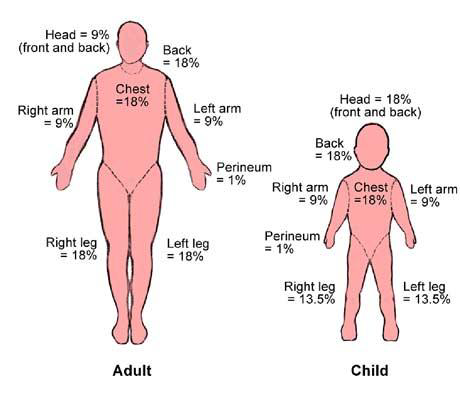
Burn is an injury to the skin or tissue results from excessive exposure to thermal, electrical, chemical and radioactive agents. Determination of the size and depth of a burn sets the guidelines for resuscitation.
Burn depth is classified as first, second, or third degree (Figure 8:1 and Table 8:1). First degree burns result from damage to the superficial layers of the epidermis. They are characterized by erythema (redness on the skin) and pain. No open wound is produced and fluid loss and systemic response is minimal. First degree burns are not considered significant and they are not considered when burn size is calculated for fluid resuscitation. Areas of first degree burn have to be appreciated and ignored in calculations of burn size for resuscitation.
Extension of thermal damage to the dermis results in second degree burns. They may be further classified as superficial or deep second degree burns. Superficial injury results in a very painful wound that is blistered or weeping. The wound is pink and blanches with light pressure. This wound typically heals within 10–20 days with minimal to no scarring if infection is avoided. Nevertheless, areas of superficial second degree burn exceeding 20 percent TSBA may require fluid resuscitation and monitoring.

| Degree of burn | Depth |
|---|---|
| First degree | Epithelium |
| Superficial second degree | Superficial dermis |
| Deep second degree | Deep dermis |
| Third degree | Destruction of all layer of tissue including subcutaneous tissue and nerve ending |
Deep second degree burns extend to the deep dermis. The wounds are drier and are red rather than pink. These burns will take more than 20 days to heal and can result in significant hypertrophic scarring.
Coagulation of the entire dermis results in third degree burns. These wounds may be charred (blacken) or white to deep red. They are insensate to pain, although pressure may be noted with palpation.
The size of the burned area (Figure 8:2) as a fraction of the total body surface area (TBSA) is estimated by the rule of nines. In an adult, the head contributes to 9%; the upper extremities, 18%; the trunk, 36%; and the lower extremities, 36% of the TBSA. These proportions are somewhat different in children, depending on the age and size.

Major burns are full-thickness burns involving >10% of the TBSA; partial-thickness burns covering >25% of TBSA in adults and over 20% at the extremes of age; burns involving the face, hands, feet, or perineum; inhalation, chemical, and electrical burns; and burns in patients with severe preexisting medical disorders are considered to be major burns. In an adult the palm of the hand is approximately 1% of surface area.